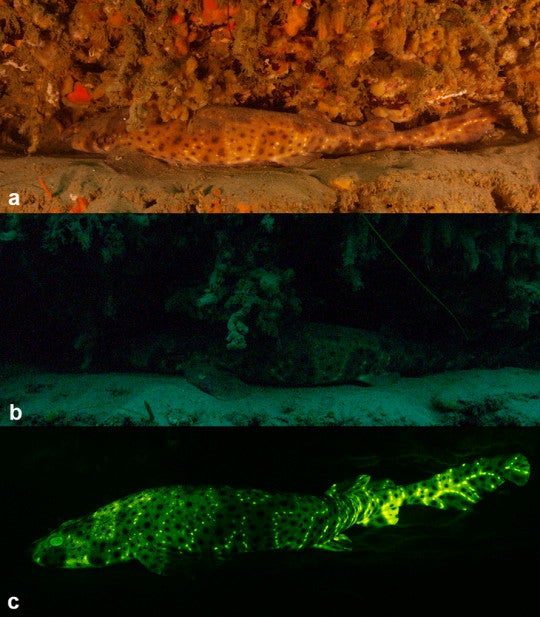This article was published in Scientific American’s former blog network and reflects the views of the author, not necessarily those of Scientific American
Until a few years ago, no one knew that many of the fish of the world harbored an electric secret: like some minerals and coral, they fluoresce.

By Sparks, J. S.; Schelly, R. C.; Smith, W. L.; Davis, M. P.; Tchernov, D.; Pieribone, V. A.; Gruber, D. F. - Sparks, J. S.; Schelly, R. C.; Smith, W. L.; Davis, M. P.; Tchernov, D.; Pieribone, V. A.; Gruber, D. F. (2014). "The Covert World of Fish Biofluorescence: A Phylogenetically Widespread and Phenotypically Variable Phenomenon". PLoS ONE 9: e83259. DOI:10.1371/journal.pone.0083259., CC BY 4.0, https://commons.wikimedia.org/w/index.php?curid=30540872
That is, when struck by one color of light, their bodies emit another. In effect, they convert the blue light of the deep sea into a color not normally available at depth – red, perhaps, or green. Unlike organisms that employ bioluminescence, biofluorescence is passive and can be carried out repeatedly for free, like a solar thermal array. Why they might fluoresce was another question entirely.
On supporting science journalism
If you're enjoying this article, consider supporting our award-winning journalism by subscribing. By purchasing a subscription you are helping to ensure the future of impactful stories about the discoveries and ideas shaping our world today.
Since water filters most colors of light out with increasing depth starting with red and moving toward progressively shorter wavelengths (orange, yellow, green etc.), the deep sea is a largely blue affair. Fish that possess the ability to fluoresce seem to do so for the purpose of communicating with their kind, who have eyes adapted to see their fluorescence. At the same time, they remain invisible to predators whose visual systems focus on deep-sea blue and are unable to see other colors. Fish that are highly camouflaged especially seem to take advantage of this system, since they would be so hard to see by their fellows without some sort of way of making themselves noticed to the only group they care to advertise to: potential dates.
Some American and Israeli scientists recently wondered if this was also true for catsharks, which have a highly cryptic coloration and also happen to fluoresce bright green. In addition to being fluorescent, the skin pattern of catsharks varies by sex.
These sharks have monochromatic vision – in effect, they see in something like black and white – but the scientists discovered that their single visual pigment is slightly green-shifted compared to the 465 nm blue wavelength most commonly found in the deep sea water. The pigment of the two species studied was most sensitive at around 480 nm. The fluorescence of both sharks’ skin was at about 525-550 nm. Although their pigments’ were not optimized to see the fluorescence of their skin, they would be eminently capable of seeing it. The pigment’s sensitivity perhaps represent a compromise between being able to see their kind and being able to see everything else in the deep ocean.

The swellshark (Cephaloscyllium ventriosum) "in its natural envrioment in Scripps Canyon (San Diego) under (a) white light (b) natural light (c) when excited with 450/70 nm calumniated lighting and imaged with a 514 nm long-pass emission filter." Fig. 6 from Gruber et al. 2016.
The scientists also discovered that, based on what’s known so far, the ability to fluoresce seems to have evolved at least three times in cartilaginous fish like sharks and rays (it is present in a total of five species). Since ocean creatures in general are woefully understudied and undersampled, it does seem likely other examples will be found. Still, three times is many fewer times than the ability has evolved in the bony fishes. Whatever the reason for that difference, the bony fish seem to employ fluorescence for the same reason. It’s most commonly found in camouflaged, reclusive reef fish that are hard to see with ambient light. It’s a clever system for saying “Hey there, sailor,” without being overheard by predators.
References
Gruber, David F., Ellis R. Loew, Dimitri D. Deheyn, Derya Akkaynak, Jean P. Gaffney, W. Leo Smith, Matthew P. Davis, Jennifer H. Stern, Vincent A. Pieribone, and John S. Sparks. "Biofluorescence in Catsharks (Scyliorhinidae): Fundamental Description and Relevance for Elasmobranch Visual Ecology." Scientific Reports 6 (2016).
Sparks, John S., Robert C. Schelly, W. Leo Smith, Matthew P. Davis, Dan Tchernov, Vincent A. Pieribone, and David F. Gruber. "The covert world of fish biofluorescence: a phylogenetically widespread and phenotypically variable phenomenon." PLoS One 9, no. 1 (2014): e83259.